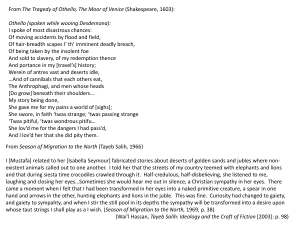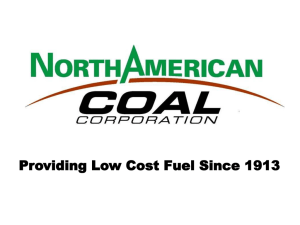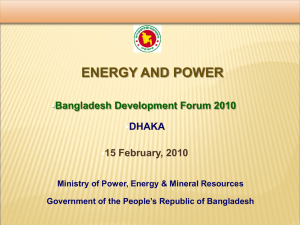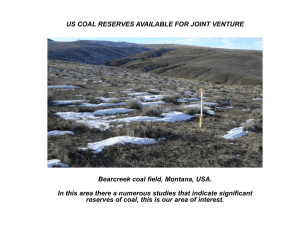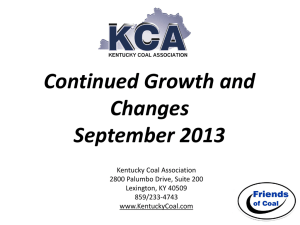15 Points of Size-Up
advertisement
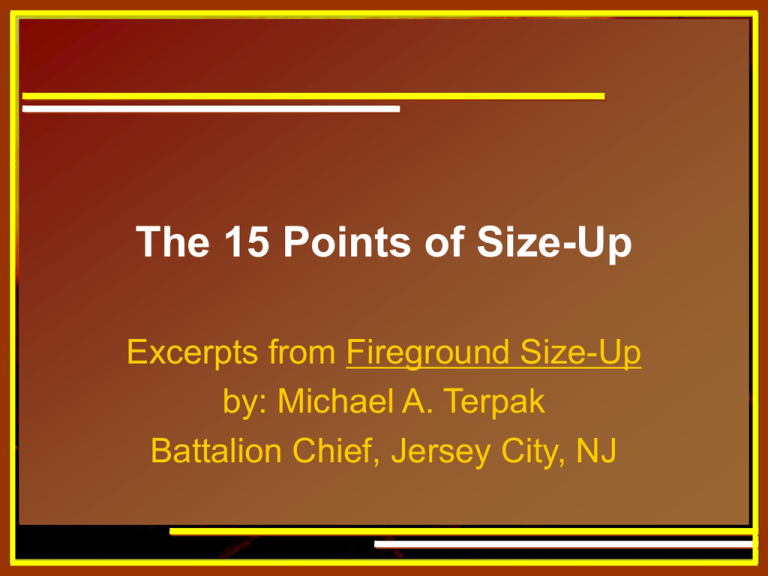
The 15 Points of Size-Up Excerpts from Fireground Size-Up by: Michael A. Terpak Battalion Chief, Jersey City, NJ COAL TWAS WEALTHS Construction Occupancy Apparatus & Staffing Life Hazard Weather Exposures Area Location & Extent of Fire Time Terrain Height Water Supply Special Considerations Auxiliary Appliances & Aides Street Conditions Construction: Size-Up COAL TWAS WEALTHS The Classes of Construction • Class 1: Fire Resistive Construction • Class 2: Noncombustible/Limited Combustible Construction • Class 3: Ordinary Construction/ Brick & Joist Construction • Class 4: Heavy Timber Construction • Class 5: Wood Frame Construction • Hybrid Construction Class 1: Fire Resistive COAL TWAS WEALTHS Favorable Characteristics • Structural components do not add to fire load/spread • Compartmentalization Class 1: Fire Resistive COAL TWAS WEALTHS Negative Characteristics • Heat • Forcible Entry • Large, open spaces • Ventilation Class 1: Fire Resistive COAL TWAS WEALTHS Collapse Concerns • Spalling • Suspended Ceilings Class 2: Noncombustible COAL TWAS WEALTHS Favorable Characteristics • Structural components do not add to fire load/spread Negative Characteristics • Everything else is negative…and you’ll see why • Most prone to collapse Class 2: Noncombustible COAL TWAS WEALTHS Collapse Concerns • Unprotected Steel • Steel Deck Roofs Class 3: Ordinary Construction COAL TWAS WEALTHS Favorable Characteristics • Exterior walls do not add to fire load • Normally smaller in avg. square footage than Class 1 or 2 buildings Class 3: Ordinary Construction COAL TWAS WEALTHS Negative Characteristics • Alterations • Concealed spaces and voids Collapse Concerns • Parapet Wall • Hanging Ceiling Space/Multiple Ceilings Class 4: Heavy Timber COAL TWAS WEALTHS Favorable Characteristics • Surface-to-mass ratio • Lack of void spaces Negative Characteristics • Heavy fire conditions will produce tremendous heat • Severe exposure problems Class 4: Heavy Timber COAL TWAS WEALTHS Collapse Concerns • Collapse will generally encompass large areas • Structural debris thrown extended distances Class 5: Wood Frame COAL TWAS WEALTHS Favorable Characteristics • Generally the smallest avg. square footage of construction types Negative Characteristics • Fire spread • Structural components add to fire load/spread • Interior stairways act as vertical artery Class 5: Wood Frame COAL TWAS WEALTHS Collapse Concerns • Entire structure is combustible • Upper floors are often supported by smalldiameter wood members • Lightweight wood truss construction Occupancy: Size-Up COAL TWAS WEALTHS • • • • Occupancy Classification Occupancy Load & Status Occupancy Content Occupancy/Construction Associations Occupancy Classification COAL TWAS WEALTHS • • • • • • • Residential Commercial Mixed (combo. of residential & commercial Institutional Educational Health care Manufacturing Occupancy Load & Status COAL TWAS WEALTHS • How many people are in the building at this time? • Are they young or old? • Are they ambulatory or non-ambulatory? • Are they awake or asleep? Occupancy Content COAL TWAS WEALTHS • Are there haz-mats in this building? – Reactivity; together or w/ water? – Flammability/combustibility? – Radioactivity? – Health concerns? – Specific hazards? • What is the building’s fire load? – Light, medium, or heavy? Occupancy Content COAL TWAS WEALTHS • Are there any specific stock concerns within the building? Examples… – Plumbing supply warehouse – Carpet and rug store – Toy stores • Is there any water absorbent stock within the building? – Increased load concerns – Stock swelling could push out walls • What is the content value? – Jewelry shops – Computer stores – Museums Apparatus & Staffing: Size-Up COAL TWAS WEALTHS • Staffing – Decreased volunteer response during the daytime hours – Decrease in number of active volunteers – Minimal number of career firefighters due to budget contraints Apparatus & Staffing: Size-Up COAL TWAS WEALTHS • Response compliment & capabilities – Number & capability • How many apparatus are responding to your incident • What types of apparatus are responding to your incident – Resource typing • A “ladder company” can mean different things – Is it a tower ladder, a ladder tower, a snorkel, a quint? Life Hazard: Size-Up COAL TWAS WEALTHS • Firefighters – Incident Command System – Accountability System – Training – Situational Awareness Life Hazard: Size-Up COAL TWAS WEALTHS • Occupants – Areas of greatest danger in a building • • • • • The fire floor The floor above the fire The top floor Floors in-between Floors below the fire – Occupant life hazard concerns • • • • • • The number Their location Their condition Accessibility Resources Care Life Hazard: Size-Up COAL TWAS WEALTHS • Bystanders – Anyone near the scene perimeter • Other emergency service personnel – EMS – Law Enforcement – Public Works – EMD Terrain: Size-Up COAL TWAS WEALTHS • Topography and/or obstructions that might interfere, delay, or cause concern with our operations – Setbacks – Buildings built on a grad – General accessibility Terrain: Size-Up COAL TWAS WEALTHS • Setbacks: Buildings set back from the street/road & buildings surrounded by and set back bay decorative landscaping – Concerns include • • • • • Apparatus placement Hoseline selection, stretch, & placement Water supply (long driveways, etc.) Equipment needs (how do we get it all there?) Can the building be reached by the aerial device? Terrain: Size-Up COAL TWAS WEALTHS • Buildings built on a grade – Buildings that appear to be two stories from the street, may actually be three stories from the rear. • Could lead to misdirection in a rescue attempt • Could lead to unintentionally placing firefighters above the fire • General accessibility – Anything that gets in the way • On the ground: fences, cars, trees/shrubs, etc. • Overhead: tree limbs, electrical lines, cables, telephone wires, etc. Water Supply: Size-Up COAL TWAS WEALTHS • Water Availability – Hydrant, dry hydrant, landing, lake, pond, etc. – Need to know where the closest water is located ahead of time • Water Needed – “Big fire = Big water” – “Big water = lots of people” • Water Delivery – Water Shuttle – Supply Hose – Nursing Operations Auxiliary Appliances & Aides: Size-Up COAL TWAS WEALTHS • Detection Equipment – Smoke Detection – Heat Detection – Flame Detection • Suppression Equipment – Sprinkler Systems – Standpipe Systems – Special Extinguishing Systems • Aides/Assistants – People that can provide assistance and/or information at a specific incident Street Conditions: Size-Up COAL TWAS WEALTHS • Street Width – Direction of approach – Apparatus positioning • Traffic Flow – Two-way or one-way? • Street Surface – Asphalt, concrete, dirt, stone, gavel – Stability for heavy apparatus – Water run-off or collection • Unusual – Know and anticipate difficult areas • Flood prone, etc. Weather: Size-Up COAL TWAS WEALTHS • Wind – Gusting or sustained winds above 10 mph should be considered significant • Concerns include ventilation, hose stream reach and penetration, etc. • Temperature – Cold: temperatures below 40°F • Firefighters fatigue early; promotes conditions that cause slips and falls; long durations of exposure dull the senses • Considerations need to be given for evacuated occupants – Hot: temperatures above 85°F • Heat exhaustion and heat stroke • Require early and frequent reliefs & rehab • May require additional alarms to relieve firefighters Weather: Size-Up COAL TWAS WEALTHS • Humidity – Reliefs: concerns of heat exhaustion & heat stroke – Fire spread: Low humidity increases fire spread concern – Ventilation: High humidity often leads to temperature inversion, which can decrease visibility; maybe even make it difficult to find which building is actually on fire • Precipitation – Heavy precipitation may increase FD’s response time – Heavy precipitation may make some roads impassible Exposures: Size-Up COAL TWAS WEALTHS • Life Hazard – Buildings prioritized by “the most severely threatened exposure” vs. “the most severely threatened life exposure”…there’s a difference • Location & Extent of the Fire – Current fire involvement w/ its extension probability & possibility • Exposure Proximity – Attached or separated, & by how much? Exposures: Size-Up COAL TWAS WEALTHS • Fire Building Construction & Features – Exterior sheathing, air shafts between the buildings, common attics/cocklofts, etc. • Exposure Building Construction & Features – Exterior sheathing, air shafts between the buildings, common attics/cocklofts, etc. • Wind – Consider its speed and direction Exposures: Size-Up COAL TWAS WEALTHS Exposure Designation Area: Size-Up COAL TWAS WEALTHS Area: the square footage involved & the square footage threatened Concerns 1. Irregular shaped buildings 2. Irregular shaped areas 3. Interconnected buildings 4. Hidden areas 5. Overall square footage Location & Extent of Fire: Size-Up COAL TWAS WEALTHS The most influencing factor of size-up Considerations for: • Below grade fires • Lower-level fires • Top-floor, attic, & cockloft fires • Upper-level fires Time: Size-Up COAL TWAS WEALTHS • Time of day/day of the week – Occupants – Traffic • Time of the year – Fire/occupant loads • Burn time Height: Size-Up COAL TWAS WEALTHS • Height Accessibility – Can the ladders reach? – Can the hose streams reach? – Elevators? – Stairs? • Smoke Behavior – Stack effect – Reverse stack effect – Stratification Special Considerations: Size-Up COAL TWAS WEALTHS • • • • High rise buildings Row houses/town houses Vacant fire buildings Manufacturing processes
